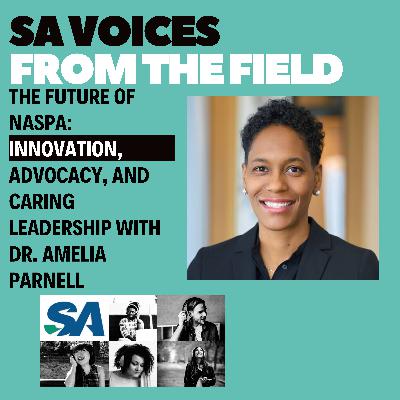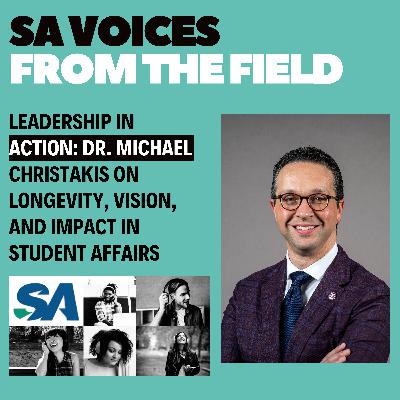Demystifying Interim Leadership: Insights from Jen Myers Pickard and Leanna Fenneberg
Description
Student affairs professionals often encounter interim leadership positions, which can significantly impact a university's trajectory. This podcast episode from "Student Affairs Voices from the Field" explores the nuances of interim leadership with insights from Dr. Jen Myers Pickard and Dr. Leanna Fenneberg.
What is Interim Leadership?
Interim leadership occurs when a temporary leader steps into a role during a transition period at a higher education institution. As Dr. Jen Myers Pickard explains, there are typically two types of interim leaders: those who come from within the institution and those brought in externally. Internal interims can offer continuity, while external interims bring fresh perspectives and prevent internal disruption.
The Purpose of Interim Leadership
Dr. Pickard and Dr. Fenneberg articulate the goals of interim leadership. Universities may choose interim leaders to maintain momentum on strategic priorities, provide specific expertise, or mentor existing teams. Interim roles can also facilitate necessary changes without long-term commitments, allowing institutions to address pressing issues such as restructuring or leadership challenges.
Inherent Challenges and Considerations
For many institutions, the decision to bring in an external interim leader raises questions about its impact on current staff. Concerns exist that an interim leader might delay significant initiatives or focus solely on maintaining existing processes. Dr. Fenneberg shares her experiences, emphasizing the importance of addressing such concerns through active engagement and transparent communication with all campus stakeholders.
Transitioning from Interim to Permanent Roles
Some interim leaders see their positions as stepping stones to permanent roles. Dr. Pickard advises having candid conversations with supervisors about potential long-term opportunities. Understanding the contractual terms of interim placements can also influence whether one can be considered for the permanent position.
Deciding on Interim Leadership
Choosing interim leadership as a career step can be strategic. Dr. Fenneberg discusses her decision-making process, which involved balancing the need for employment and her commitment to family. She underscores the role of networking in finding interim positions, while Dr. Pickard emphasizes reaching out to placement firms to explore opportunities.
Embracing the Interim Role Fully
Dr. Fenneberg and Dr. Pickard agree on the importance of fully engaging with interim roles. By adopting a proactive approach, interim leaders can make meaningful contributions to their institutions. This includes mentoring teams, sustaining strategic initiatives, and exploring opportunities for personal and professional growth.
Interim leadership in higher education presents unique challenges and opportunities for growth. By engaging fully and understanding the context of their roles, interim leaders can significantly impact their institutions while setting the stage for future success.
TRANSCRIPT
Dr. Jill Creighton [00:00:01 ]:
Welcome to Student Affairs Voices from the Field, the podcast where we share your student affairs stories from fresh perspectives to seasoned experts. Brought to you by NASPA, we curate free and accessible professional development for higher ed professionals wherever you happen to be. This is season 12, continuing our journey through the past, present, and future of student affairs. I'm Dr. Jill Creighton, she, her, hers, your essay voices from the field host. Today on essay voices, we're exploring the topic of interim leadership with two wonderful colleagues, Dr. Jen Myers Pickard and Dr. Leanna Fenneberg. Based in Tucson, Arizona, Jen brought her skills to Whit Kiefer after nearly two decades in academic and student affairs roles at AAU institutions, first at Northwest University and the University of Maryland and later at the University of Arizona. Jen has a broad insight into the inner workings of higher education institutions and is driven by passion to find the right leaders for specific client needs. Her search expertise includes presidents, provosts, deans, and leaders in a wide variety of administrative units, including student affairs, student success, research and innovation, and finance and administration.
Dr. Jill Creighton [00:01:05 ]:
Jen joined Whitkey for after nineteen years in higher ed, most recently serving as the AVP for divisional initiatives and planning within student affairs and enrollment management, academic initiatives, and student success at the University of Arizona. In this role, Jen functioned in a chief of staff capacity, extending the vision and capacity of senior institutional leadership through work on change management initiatives, executive level talent acquisition, oversight of institution wide assessment efforts, and leadership of faculty student engagement and success programs. Jen is very proud of her leadership and administrative roots within the field of education. As such, she's deeply committed to the cultivation of emerging higher education professionals, continuing to develop and facilitate leadership institutes and conference sessions, and being active in NASPA along with other higher ed organizations. Additionally, Jen joined the board of the International School of Tucson in January of twenty twenty and was named board chair in June of twenty twenty one. Dr. Leanna Fenneberg is a recent NASPA pillar of the profession and has dedicated over twenty five years in higher education and student affairs. Committed to advancing the potential of all students, Dr. Feeneberg's leadership focuses on diversity, equity, and inclusion, holistic student success and well-being, and the role of campus partnerships in transformational learning. A servant leader, colleagues describe her as a source of energy and purpose, driven by integrity, care for others, and an unwavering work ethic.
Dr. Jill Creighton [00:02:19 ]:
Dr. Fenenberg serves as senior vice president for student life at Duquesne University in Pittsburgh, Pennsylvania, following a career spanning functional areas, including housing, first year experience, and student success, earning early recognition as an astounding first year student advocate by the National Resource Center for the First Year Experience and Students in Transition. NASPA has been a primary professional place of inspiration and connection. She's served on the NASPA board of directors as director of knowledge communities, as cochair for the Women in Student Affairs WISA, and the student affairs partnering with academic affairs SAPA knowledge communities, and recently the director for the Alice Manaker Symposium. Her expertise is evidenced through peer reviewed articles, countless national presentations, and instruction in masters and Dr.al programs in higher education administration. As a first generation college graduate, Dr. Fenneberg holds a PhD in higher education administration from Saint Louis University, an MEd in student personnel services from the University of South Carolina, and a BA in communication from Marquette. She's a devoted wife, mom of two sons, and two cats, and finds joy in travel and reading. Welcome to Essay Voices. Today, we have Jen.
Dr. Jill Creighton [00:03:20 ]:
Hi, Jen. Hi. How are you? And Liana. Hello. So glad to be featuring you both, and I love it when we get to do episodes where we can get two perspectives on the same topic, which is what we're gonna be doing today, talking all about interim leadership placement processes in higher ed leadership. I think this is an area of higher ed leadership that has a little bit of mysticism around it. So I'm looking forward to demystifying how we get into interim leadership placements through formalities and search versus maybe informal interim placements and what it's like to be in that interim seat, which I know has both pros and cons to it. But before we get into the topic, we'd love to get to know you both a little bit better.
Dr. Jill Creighton [00:04:00 ]:
So, Jen, let's start with you. How did you get to your current seat at WKiefer?
Dr. Jen Myers Pickard [00:04:03 ]:
Sure. Very happy to share that briefly. Well, so my name is Jen Pickard. It's great to see you all or be with you here today. I actually came to my seat at Wake Kiefer via twenty years of being on campuses. So I actually started in sort of the in the traditional student affairs manner, thought I wanted to be a Dean of Students when I grew up, was heading into my Dr.ate, doing all that work in assessment and research actually at that time, and then moved into a position at the University of Arizona. It was a chief of of staff type of role at a very large division that oversaw student affairs, enrollment management, academic initiatives, and student success. Say that fast a few times.
Dr. Jen Myers Pickard [00:04:39 ]:
And it was a great and wonderful role because I with Kiefer, just a very right moment in time, I decided to jump on the search bandwagon that was in the summer of twenty eighteen. Six and a half years later, I'm now a senior partner and the head of our student affairs practice.
Dr. Jill Creighton [00:05:05 ]:
And, Liana, you are in a new role right now, but you also have gone through the Kiefer process through interim placement. But how did you get to your current VPSA seat?
Dr. Leanna Fenneberg [00:05:14 ]:
Yes. Absolutely. Hello, everyone. Liana Fetterberg. I serve as the senior vice president for student life at Duquesne University. I'm in my ninth month here on campus, so it is a newer role. I've been i
























